Introduction
Have you ever wondered what its like to build a miniature planet Earth in your Science classroom? Well, myself and two other classmates have done that very thing. We call them, Ecobottles. Ecobottles have three main chambers, each acting as different parts of the Earth. The terrestrial chamber, which is where things like plants and small creatures would live, the decomposition chamber, which is the same as under the surface of the Earth, and the aquatic chamber, which is the same as the oceans and lakes on the Earth. Through this process of creating a miniature Earth, we have we have been able to carefully watch the Ecobottle and see exactly how and why its changing. And in a sense, its almost like how our planet changes and reacts to certain situations that it is put into.
Bought and collected supplies including:
- Apple Snail
- Dirt from Snail3's front yard
- Snail eggs
- Soil
- Unknown plant
- Common Ground Beetles
- 5 Empty 2-Liter bottles
- water from Snail1's 10 gallon tank
- Purified Water
- Orange peel
- Pond water
- Unknown water plant
In order to build a bottle you need to:
- Drill 4 small holes and 1 large hole in the caps of the 2 liter bottles
 Click on an image to view larger version & data in a new window
Click on an image to view larger version & data in a new window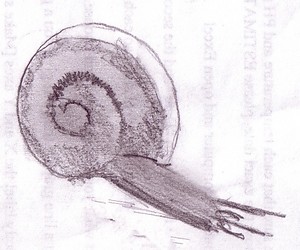
The Apple Snail eats very fragile materials like dead fish. Their blood is also much like humans so it turns the snail a reddish color.© 2005 Snail1
- Screw them on the bottles
- Cut each bottle in half except one, this one you cut off the very bottom and very top
- Use the upper half of 4 bottles with the cap face down then tape them overlapping together.
- Then weigh the materials and put them in the bottles
- Add in the top portion of the 1 bottle you cut off and use as a spout to add water to every few days
During completion of construction of our ecobottle, our apple snail died. We fed it to the ground beetle then sealed the EcoBottle on September 29th. A small hole was cut just above sea level (water level) in order to take water samples for pH testing and water temperature testing. When testing was finished for the day, we would tape up the hole. Several of these holes were made after losing the location of the previous hole.
Hypothesis
When we began we thought the snail we put in the aquatic chamber would live. We were hoping for fruit flies from the soil but, we didn't get any flies, we got maggots, flies in the larval stage. The plant we put in the terrestrial chamber we knew would do well, which it did very well because of the conditions of the moist soil, the humidity in the chamber and the sunlight. There was a pretty good quantity of mold in the decomposition chamber. We didn't know if we were going to get any mold. We figured the temps inside the ecobottle would be stable (26 degrees celsius).
Observations
10/2: During completion of the ecobottle, our Apple snail died due to dirty water and not enough food. Mean while, we've been busy constructing the terrestrial and the decomposition chambers. We are going to take the snail out of the Aquatic chamber and put it in the Decomposition chamber. We also added two orange peels to the decomp. chamber.
10/3: The decomposition chamber has grown mold over the weekend due to the dead snail and the orange peels that we added on 10/2. All of the dirt in the decomp. and the terrestrial chambers have turned from a light tan color to a dark black color. This is happening because of the moisture that is circulating around the ecobottle caused by the straws that are throughout the ecobottle.
10/4: As of today, more mold has grown in the decomposition chamber. The terrestrial chamber is showing signs of moisture caused by precipitation. And the Aquatic chamber is still looking relatively clean.
10/6: We have just added 20oz. of water to the ecobottle through the precipitation Chamber. This is the final time that we will be able to add or take away any substance or object to our ecobottle. We have also noticed that moisture is building up in the precipitation chamber. This is showing good signs of life because the plants in the Terrestrial Chamber are showing signs of growth.
10/14: This is the first time that my group and I have had to check the temperature of the water in the aquatic chamber, On this first test we got 26C. This temp is about the same as room temp(76F).
10/17: The pH of the water in the aquatic chamber in our ecobottle is 8, and this is good because things can live in environments with the PH between 6-8. The temp. of the water is 27C. As of today, the soil in the decomposition chamber is covered in mold or fungi do to the orange peels that we added yesterday. In the terrestrial chamber, the unknown plant seems to be maintaining its health because it hasn't showed any signs of of dying And for the aquatic chamber, the water still looks black and we are unsure if there are any organisms living in chamber.
10/21: There are signs of moisture entering the terrestrial chamber because the soil is dark and moist and not light and dry like it was when we put it in the Ecobottle. This is good for the plant because it is obviously getting the nutrients it needs to survive.
Note: The dates for these observations are not consistent because we didn't observe each and every day.
Analysis
R.I.P. (Death dates of all organisms that died in our ecobottle)
- Apple Snail eggs: During completion
- Apple Snail: September 29, 2005
- Ground beetle 1: September 29, 2005
- Ground beetle 2: September 29, 2005
View a graph of water temperature through time View Snail Temp Graph
View Snail Temp Graph

This is a clay model of an apple snail constructed by Snail1. To the right of the model you can see which colors represent which anatomical parts of the snail. © 2005

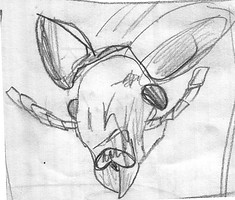
Ground beetles live and dwell in moist places like under wood and rocks. They are one of the small predators of the insect world. © 2005 Snail1

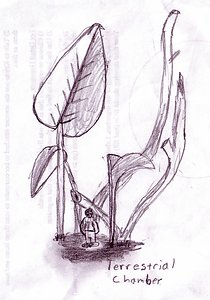
Plants have little veins which transport water through their leaves. This water is absorbed by the roots. © 2005 Snail1
Class Analysis
Organisms in Class Ecobottles
- Snail - 1
- Snail eggs - All
- Ground beetles - All
- Maggots - ?
- Crickets - 3
- Fish - All
- Scorpions - 1
- Grasshopper - 1
Conclusion
In the final days of the ecobottle project, the scientists in our group noticed that what we had just created was more than just a science project, it was the truth of how our planet Earth really reacts to what is put into it or taken out of it. This ecobottle project has helped us realize that all it takes is one small thing to change the outcome on the future of the planet.
Information on the Internet
- Annenberg Media: Bottle Biology The Bottle Biology site is a great place to learn about how to make ecocolumns.
- Wisconsin Fast Plants The Fast Plants site provides a wealth of information on how to use special types of plants for ecobottle investigations.

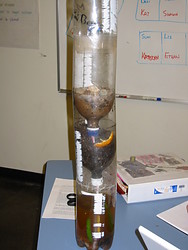
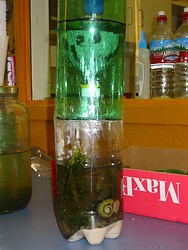
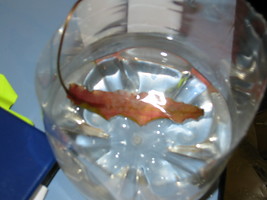

 Go to quick links
Go to quick search
Go to navigation for this section of the ToL site
Go to detailed links for the ToL site
Go to quick links
Go to quick search
Go to navigation for this section of the ToL site
Go to detailed links for the ToL site